#sonoluminescence
Explore tagged Tumblr posts
Text

Seth J. Putterman, Sonoluminescence: Sound into Light, Scientific American Magazine Vol. 272 No. 2 (February 1995), p. 46
#physics#Seth Putterman#Putterman#acoustics#sound#light#sonoluminescence#atom#science#sound wave#energy
54 notes
·
View notes
Text
Sonoluminescence is when you collapse an underwater bubble using a soundwave... And it produces light.
And nobody knows why it happens!
5 notes
·
View notes
Text
Sonoluminescence - If you collapse an underwater bubble with a soundwave, light is produced, and nobody knows why
#sonoluminescence#science knowledge#science#bubble#soundwave#interesting as fuck#interesting facts#science facts
3 notes
·
View notes
Text
Little space colony/ floating city/ carved out mountain city/ what have you whose power is generated by sonoluminescent cavitation boilers (like the light produced from a pistol shrimp claw blast thing, where a bubble is formed underwater simply from the pressure of the shockwave, the same is done largescale with resonance and feedback loops)
Because of the size of the boilers and the energy involved, a much much denser liquid is used (maybe even like a tar, an amber? Maybe liquid glass? Superheated heavy metal?) and a much much larger solitary bubble is produced, collapsed, cavitated, and then the energy of that radiation emission is captured.
The way the sound is produced at a low energy cost is by using feedback loops of enormous glass bells and tubes and harmonic metal tines and springs, it results in an 'apprehension engine' sounding hum, both low and high pitch, that builds to an immense and wildly dangerous volume, building up static energy in the air around it and messing with pretty much everything, then, when the bubble collapses, there's what is functionally a shockwave earthquake through the whole colony.
About every 4 hours (every 3 hours and 59 minutes to be precise) the warning bells chime,the boiler engine activates and begins its wind up, and after about 55 seconds of increasing volume, vibration, charge and pressure, the bubble that was forming spontaneously collapses, and the energy from shockwave and electrolysis radiation from the cavitation of the bubble is collected and stored to power the colony (and to add to the ancillary backup engine to assist with the engine bubble production in less than ideal situations for input energy)
The effects of this bubble collapsing is felt over the entire population, with those closer to the engines experiencing the most extreme effects, but even those farthest away still being at risk if they ignore safety procedures. Aftereffects, tremors, side effects, and atmospheric crackling and rebalancing can last up to an additional minute the closer you are to the engine (in civilian spaces that is. In the spaces wete the boiler technicians work, it is up to half an hour at the closest)
Inhabitants and those familiar with the city are able to instinctually hear the building beginning chimes of the engine and prepare accordingly (kind of like not worrying or paying attention to a siren at 12 o clock on a wednesday, except it's more like 3 times a day every day)
Visitors and youngsters have alarms on their wrists at 10 and 5 minutes before the engine activates, and an additional 1 minute alarm if opted for
Infants and enfeebled are usually placed lovingly in a home's cavitation chamber, and occaisionally stayed with for added comfort (a sound "proofed" and well insulated and vacuum sealed chamber than dampens the intense noise and the shaking and shockwave effects as well as the atmospheric static energy) those rich enough to afford them have either entire houses soundproofed, or have a luxurious chamber
Those technicians who are very savvy can usually wait up until the last 10 or so seconds before donning their mouth guards and assuming the shock position
Daredevils and those reckless and irresponsible will occaisionally ignore the safety measures, choosing not to don their ear protection and mouth guard
Choosing to continue with whatever task they were doing. Sure, most of the time they are fine, mostly they are instinctively prepared for it and it's a small risk, but there are regular and plentiful cases of that risk having conseques, whether minor (such as a chipped tooth or a cut tongue from biting it, a falling injury or some kind of impact damage or joint damage from muscle spasms, hearing damage, tinitus, sprains) to major (seizures lasting beyond the usual maximum 15 seconds after the cavitation, occaisionally up to minutes, causing significant risk of harm to individual, broken bones, heart attack, suffocation, torn muscle and dislocated joints, ruptured eardrum, severe burns from contact with metal or technology or liquid, "the bends" nitrogen narcosis, and more)
2 notes
·
View notes
Text
Maybe we were merely two souls,
Crossing only once in space and time,
Creating echoes of sound and light,
That rip through the paper-like black
And rained down like meteor showers
Across the divided galaxies, through the split bubbles of time, forming the light I now call mine
A galaxy divided, now in quiescence, wishes to burst with iridescence,
In a tale of sonoluminescence
#spilled poetry#poetry#spilled ink#astro poetry#poets corner#sonoluminescence#my journal#midnight poems#midnight poetry#poemblr
0 notes
Text
-luminescence; light
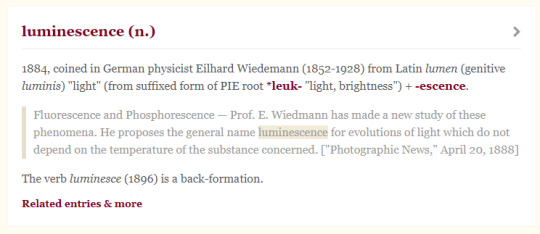
youtube

0 notes
Link
The Mysteries of Cavitation What You Need to Know Cavitation is a phenomenon that transcends the boundaries of science, impacting various industries and natural processes. At its core, cavitation is a complex interplay of physics and fluid dynamics, revealing intriguing mysteries beneath the surface. Exploring the Phenomenon of Cavitation Cavitation is more than just bubbles forming in liquids; it's a fascinating phenomenon with far-reaching implications. It occurs when changes in pressure within a liquid lead to the formation and collapse of tiny vapor-filled cavities. These implosions generate shockwaves, creating unique challenges and opportunities in diverse fields. [caption id="attachment_53635" align="aligncenter" width="738"] cavitation[/caption] Significance of Cavitation in Modern Industries Cavitation isn't confined to laboratories; it plays a pivotal role in industries such as manufacturing, energy, and aerospace. Understanding and controlling cavitation is essential for optimizing machinery performance and ensuring safety. From propellers to industrial pumps, cavitation's effects can be both beneficial and destructive. The Science Behind Cavitation To comprehend cavitation fully, we delve into the underlying science. This section explores the principles of fluid dynamics, pressure differentials, and the factors that trigger cavitation. Understanding the science behind cavitation is key to harnessing its power and minimizing its adverse effects. Types of Cavitation: Uncovering Variations Cavitation isn't a one-size-fits-all phenomenon; it manifests in various forms, each with its characteristics and effects. Liquid Cavitation: A Deep Dive Liquid cavitation occurs when changes in pressure cause the formation and collapse of vapor-filled cavities in a liquid medium. This type of cavitation is common in hydraulic systems, where fast-flowing liquids create areas of low pressure. Liquid cavitation can lead to erosion and damage to industrial equipment. Gas Cavitation: Understanding the Differences Gas cavitation, on the other hand, involves the formation and implosion of vapor-filled bubbles in a gas medium. This type of cavitation is crucial in understanding the behavior of propellers and hydrofoils in air. Gas cavitation's effects differ from liquid cavitation and are essential considerations in aerospace and high-speed applications. Vaporization Cavitation: A Unique Perspective Vaporization cavitation is a distinct type that occurs when a liquid undergoes rapid changes in pressure, causing it to vaporize and form cavities. This phenomenon is often encountered in medical ultrasonic devices and can be harnessed for diagnostic and therapeutic purposes. Vaporization cavitation showcases the versatility of this phenomenon in various fields. Causes and Symptoms of Cavitation Cavitation doesn't occur in isolation; it's driven by specific causes and manifests through identifiable symptoms. Recognizing these indicators is crucial for addressing and mitigating cavitation-related issues. Identifying Cavitation Indicators Detecting cavitation often begins with recognizing telltale signs. These signs may include unusual noises from machinery, decreased performance, or visual cues like pitting on metal surfaces. Learning to identify these indicators is the first step in addressing cavitation concerns. Common Causes of Cavitation Understanding what triggers cavitation is essential for prevention. Common causes include excessive fluid velocity, improper equipment design, and suboptimal maintenance practices. By addressing these root causes, industries can reduce the risk of cavitation-related damage. Symptoms in Industrial Equipment Cavitation's impact on industrial equipment can be detrimental. It can lead to erosion, decreased efficiency, and even equipment failure. This section delves into the specific symptoms that industrial machinery may exhibit when affected by cavitation. Impact of Cavitation: Consequences and Challenges Cavitation's effects extend beyond the initial formation and implosion of vapor-filled cavities. It can have far-reaching consequences in various industries, posing unique challenges that demand innovative solutions. Effects of Cavitation on Machinery Cavitation can wreak havoc on machinery. It leads to accelerated wear and tear, reduced efficiency, and increased maintenance costs. Understanding these effects is crucial for industries reliant on precision equipment, such as the marine and energy sectors. Mitigating Cavitation Damage Addressing cavitation-related damage requires a multifaceted approach. This section explores strategies and technologies employed to mitigate the adverse effects of cavitation, from optimizing designs to incorporating advanced materials. Challenges Faced in Various Industries Cavitation's challenges are not uniform; they vary across industries. Whether it's preventing erosion in water turbines or maintaining the integrity of medical equipment, different sectors face unique obstacles related to cavitation. We delve into these industry-specific challenges and how they are tackled. Cavitation in Engineering and Technology Cavitation's influence extends to the realms of engineering and technology, where it plays a pivotal role in diverse applications. Applications in Aerospace Engineering Aerospace engineers grapple with cavitation's effects, particularly when designing aircraft and spacecraft. Understanding how cavitation impacts aerodynamics and propulsion systems is crucial for achieving optimal performance in these high-stakes environments. Cavitation's Role in Hydrodynamics In the field of hydrodynamics, cavitation has both positive and negative implications. It can enhance the performance of watercraft but also lead to damage. This section explores how hydrodynamic engineers harness cavitation while minimizing its drawbacks. Technological Advances for Cavitation Control Technology continues to advance our understanding of cavitation and our ability to control it. We delve into cutting-edge research and innovations aimed at mitigating cavitation's effects and harnessing its potential. Medical Implications of Cavitation Cavitation isn't limited to industrial applications; it also finds critical roles in the field of medicine, offering both diagnostic and therapeutic possibilities. Cavitation in Medicine: Diagnostic and Therapeutic Uses In the medical realm, cavitation is harnessed for various purposes. It serves as a diagnostic tool in medical imaging, allowing healthcare professionals to visualize internal structures. Additionally, controlled cavitation is used therapeutically in procedures like lithotripsy to break down kidney stones. Ultrasound-Induced Cavitation in Healthcare Ultrasound technology is at the forefront of using cavitation in healthcare. Ultrasonic waves induce cavitation in tissue, facilitating drug delivery, tissue ablation, and targeted therapies. This section explores the expanding role of ultrasound-induced cavitation in improving patient outcomes. Environmental Impact and Conservation Cavitation doesn't just affect industries and machines; it also has environmental implications, especially in natural water systems. Understanding its impact and taking conservation measures are essential. Cavitation in Natural Ecosystems In natural water bodies, such as rivers and oceans, cavitation can occur due to rapid changes in pressure and flow rates. This section explores how cavitation influences aquatic ecosystems, including its effects on aquatic life and water quality. The Role of Cavitation in Water Pollution Control Surprisingly, cavitation can be employed as a tool for environmental protection. Cavitation reactors are used to treat wastewater, break down pollutants, and disinfect water. We discuss how cavitation contributes to sustainable water pollution control. Future of Cavitation Research The field of cavitation is dynamic and ever-evolving, with ongoing research pushing the boundaries of our understanding and applications of this phenomenon. Emerging Trends and Technologies Cavitation research continues to advance, driven by technological innovations and interdisciplinary collaboration. We explore emerging trends and technologies that are shaping the future of cavitation studies. Innovations in Cavitation Studies Researchers are constantly developing new tools and techniques to study cavitation at microscopic levels and in various environments. This section highlights recent innovations that contribute to a deeper understanding of cavitation. Frequently Asked Questions About Cavitation 1. What is cavitation, and how does it occur? Cavitation is the formation and implosion of vapor-filled cavities in a liquid or gas due to changes in pressure. It occurs when pressure drops below the vapor pressure of the fluid, leading to bubble formation. 2. What are the common causes of cavitation in industrial machinery? Common causes of cavitation in machinery include high fluid velocity, poor equipment design, and insufficient maintenance. These factors can create conditions conducive to cavitation. 3. How can I recognize cavitation in machinery? Cavitation can be identified by unusual noises, decreased equipment performance, and visible signs such as pitting and erosion on surfaces. Regular equipment inspections are essential for early detection. 4. Are there different types of cavitation, and how do they differ? Yes, cavitation comes in various forms, including liquid cavitation, gas cavitation, and vaporization cavitation. Each type has distinct characteristics and effects. 5. Can cavitation have positive effects in certain applications? Yes, cavitation can be harnessed for positive effects, such as improving the efficiency of water turbines and facilitating chemical reactions in industrial processes. 6. How does cavitation impact natural water ecosystems? Cavitation in natural water bodies can affect aquatic life and water quality. It is important to understand and mitigate its environmental impact. 7. What are the latest technological advancements in cavitation research? Recent advancements include high-speed imaging techniques, computational simulations, and innovative materials that enable scientists to study cavitation in greater detail. 8. Is cavitation used in medical applications, and if so, how? Cavitation has medical applications, such as diagnostic imaging using ultrasound and therapeutic procedures like lithotripsy for kidney stone treatment. 9. Are there conservation efforts to reduce the environmental impact of cavitation? Yes, conservation efforts include the development of eco-friendly equipment designs and water treatment technologies to minimize the environmental effects of cavitation. 10. What does the future hold for cavitation research and its practical applications? The future of cavitation research looks promising, with ongoing studies exploring new applications in fields like energy, medicine, and environmental sustainability. Conclusion: In the vast sea of science and technology, cavitation stands as a dynamic and intriguing phenomenon. From its roots in fluid dynamics to its diverse applications in engineering, medicine, and beyond, cavitation's influence permeates our world. As we conclude this exploration, let's recap some key takeaways. Cavitation is not a one-size-fits-all concept; it manifests in various forms, each with its effects and challenges. Understanding the causes and symptoms of cavitation is vital for prevention and mitigation.
#Acoustic_cavitation#Bubble_formation#Cavitation_bubbles#Cavitation_control#Cavitation_damage#Cavitation_in_fluids#Cavitation_phenomenon#Erosion_due_to_cavitation#Fluid_dynamics_effect#Hydrodynamic_cavitation#Implosion_of_bubbles#Pressure_induced_bubbles#Sonoluminescence#Vapor_filled_cavities#Vaporization_cavitation
0 notes
Text
this is such a compelling illustration. thank u wikipedia

13 notes
·
View notes
Text
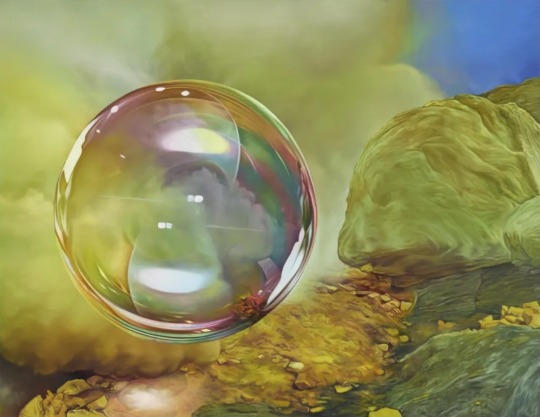
Ariana Papademetropoulos (Greek-American, b. 1990)
Sonoluminescence, 2024
oil on canvas
316 notes
·
View notes
Text

Doesn't matter if you like Ness or dislike Ness, you can't deny that he was the most beautiful child.

His childhood was exactly how one's childhood should be like—full of innocence, imagination, creativity, curiousity and pure joy. He was everything a child of his age should be like. He was such a sweet soul.
I'll never understand why his parents and even his older siblings behaved the way they did—is it just a simple portrayal of stereotype revolving around Germans being really serious people? Because Science is itself so magical—Flame test, Titration, Iodine clock reaction, etc. and there are so many scientific phenomenon like Aurora Borealis, Ball lightning, Sonoluminescence, etc. that look so wizardry!!

I'll never forgive them. You both are awful.
It wasn't shown much, but Ness was pretty lonely too, you know. I'm glad he found soccer, and in a very strange way, I'm glad he found Kaiser too.

Such a precious lil boy.

You'll forever be the most magical child I know, Alexis. I hope you'll never stop building snowmen ☃️💕
396 notes
·
View notes
Text
In sonoluminescence—as the process of converting sound into light is called—the bubble is concentrating the energy of the acoustic vibrations by a factor of one trillion. That is, the sound wave that drives the bubble is centimeters long, but the light is emitted from a region of atomic dimensions.
Seth J. Putterman, Sonoluminescence: Sound into Light, Scientific American Magazine Vol. 272 No. 2 (February 1995), p. 46
#quote#Seth Putterman#Putterman#physics#sonoluminescence#sound#acoustics#light#atom#atomic#science#energy#sound wave
35 notes
·
View notes
Text
Wet Beast Wednesday: pistol shrimp
Oh snap, it's the snapping shrimp post for Wet Beast Wednesday! Snapping shrimp or pistol shrimp are loud little critters that have evolves a very useful and fascinating tool in their pincers. Let's not waste time and shoot off to learn about these little gunslingers.
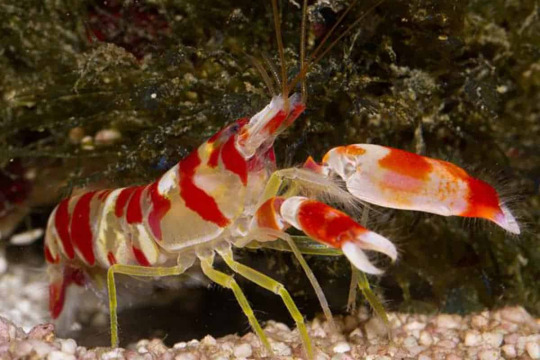
(Image: a pistol shrimp. It is a mostly white shrimp with red stripes. One of its claws is considerably larger than the other. It is standing on gravel and next to some seaweed. End ID)
Pistol shrimp are over 1,000 members of the family Alpheidae, which is part of the infraorder Caridea. This means they are true shrimp, not to be confused with superficially similar animals like brine shrimp, mantis shrimp, tadpole shrimp, and prawns. Yeah, I only recently learned that prawns and shrimp aren't a language difference between British English and American English like chips vs fries. They're not even that closely related. As true shrimp, pistol shrimp have two main body parts: the cephalothorax and abdomen, which are composed of 19 body segments. The abdomen forms a flexible tail with a fin on the end. When startled, the fin can rapidly curl under the body, propelling the shrimp backwards. Like other decapods, there are 10 limbs. The front pair of limbs have evolved into claws used to manipulate objects. The claws are the most distinguishing feature of pistol shrimp. They are asymmetrical, with one growing extremely large, over half the size of the body. The big claw has a modified version of the typical pincer. This pincer has an upper claw that can open up at a right angle. Under the claw is a pocket in the lower pincer, into which water flows. The upper pincer then slams down into this pocket, forcing the water out. The pressure of the pincer closing water in the pocket creates a cavitation bubble that is forced away from the claw at up to 26.8 meters per second. This is enough force to seriously wound small animals and hurt larger ones into leaving the shrimp alone. The cavitation bubbles can reach up to 4,427 degrees C (8,000 F) . For comparison, the surface of the sun is about 1,000 decrees (C) hotter. When the bubble pops, it creates a snapping sound that can reach 218 decibels. For comparison, most gunshots max out at around 170 db. This puts pistol shrimp is the running for the loudest ocean animals, with whales being the other main competitors. If that all sounds like a lot, the whole event happens so fast that the heat doesn't have time to affect much and the noise sounds like a moderately loud snap to us. Adults can snap their claws shut with an acceleration of up to 30 meters per second squared and juveniles can do it up to 20 times faster. The whole process takes less than a millisecond. When the cavitation bubble collapses, it can produce light. This is called sonoluminescence and nobody knows how it happens. If a pistol shrimp loses its large claw, the small claw will grow into a new large one while the missing limb will regenerate into a small claw. Adult pistol shrimp average between 3 and 5 cm long.
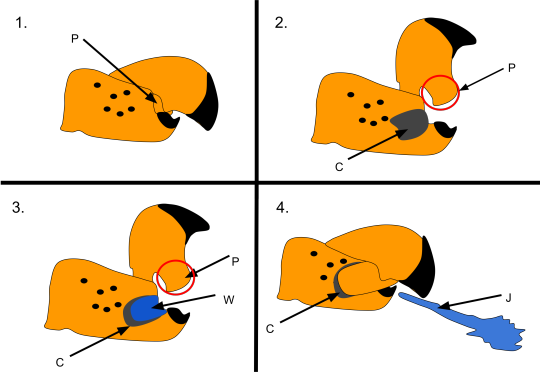
(Image: a drawing showing the process of a pistol shrimp snapping its claw. In the first panel, the claw is closed. In the second, the upper claw opens at a 90 degree angle, revealing a cavity. In the third panel, the cavity fills with water. In the final panel, the claw is closed again and a jet of water is ejected from the claw. End ID. Source: Wikipedia user Carermyers)
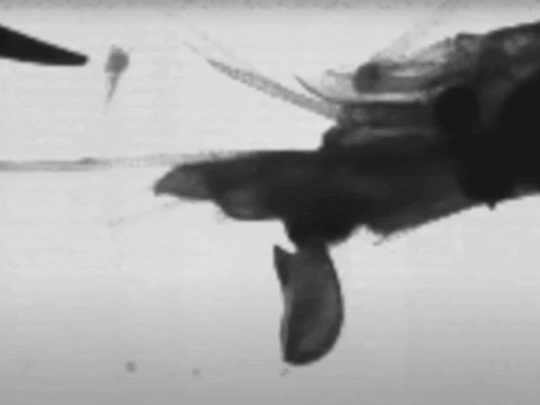
(Gif: black and white, slow-motion video of a pistol shrimp's claw snapping shut and creating a cavitation bubble. End ID. Source)
Pistol shrimp live worldwide, though most species live in tropical or temperate water. There are some cold water species and even freshwater species. Most prefer habitats where they can make burrows and where there are plenty of other animals. Coral reefs, oyster reefs, seagrass beds, mangrove groves are common habitats. Snapping is used for hunting and communication. They typically hide in burrows, waiting for fish or other small animals to pass by. When prey passes, the shrimp will snap to stun or seriously wound the prey, then drag it into the burrow. Some social species actually form eusocial hives with a single queen who produces all offspring. These shrimp are the only known marine eusocial species and all occur within the same genus (Synalpheus), though not every member of that genus is eusocial and eusociality appears to have evolved at least 3 times within that genus. It appears that a reason why only this genus developed eusociality is their larvae do not disperse, instead staying in the same area as the parents. The hives are usually located within sponges. Other social species are not eusocial, but still live together in colonies. Many less social species have formed a symbiotic relationship with gobies. Both species live in burrows, but gobies are bad at digging while the shrimp have poor eyesight. The goby will protect the shrimp while it digs a burrow, then the two live together. They will forage together, with the goby using its superior eyesight to watch for predators and warn the shrimp to get back to the burrow. Pistol shrimp are monogamous, the same pair coming back to mate over and over again (this does not apply to the eusocial species in which only the colony's queen is permitted to mate). The female is only fertile during a short period after molting. The male will stay with the female and protect her during the vulnerable period after mating and some species will remain with each other until the eggs hatch or permanently.
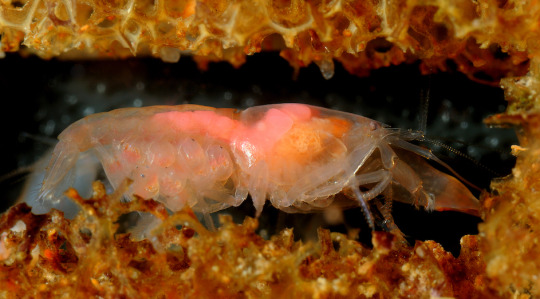
(Image: a eusocial pistol shrimp queen with eggs. Her body is translucent and multiple eggs are attached to her abdomen. The eggs look like translucent balls. The is inside of an orange sponge. End ID)
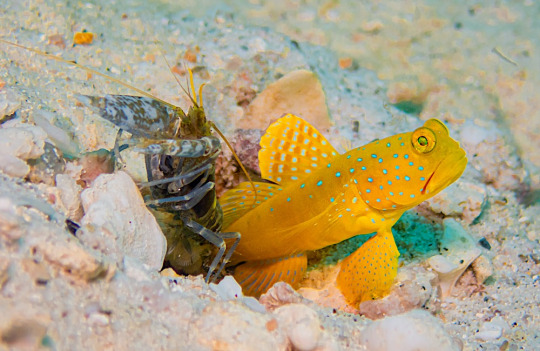
(Image: a pistol shrimp and goby emerging from a burrow in the sand. The shrimp is a mottled green and white. The body is a bright yellow fish covered with blue spots. End ID)
Pistol shrimp are a major source of noise in the places where they live. If you've ever been swimming and can hear repeated cracking noises, that may have been a bunch of pistol shrimp. Some scientists monitor the level of pistol shrimp noises as a method of monitoring the ecosystem. If the noise level drops, that is an indicator that the local ecosystem is suffering. The noise of the shrimps can get so loud that it actually interferes with sonar and forms of underwater communication. During World War II, members of the navy realized that the shrimp disrupted sonar enough to hide submarines, so they started hiding submarines near reefs with lots of the shrimp to keep them from being found by enemy subs. Weirdly not the only small marine animals to mess with submarines. I'll get the the other major one soon. The largest threats to pistol shrimp come from habitat destruction. Some species of pistol shrimp have entered the pet trade. As coral reefs, seagrass beds, and other habitats are destroyed, the shrimp that rely on them will suffer as well.

Yet another time I get to use one of these cards in a post
(Image: the Weird n' Wild Creatures card featuring pistol shrimp. End ID)
#wet beast wednesday#pistol shrimp#snapping shrimp#shrimp#decapod#crustaceans#marine biology#biology#zoology#ecology#animal facts#eusocial#symbiosis#goby#informative#image described
241 notes
·
View notes
Text
Sonoluminescence
We hear a light noise
And it could be your body double
But the actual sound of your voice
Will always burst my little bubble
107 notes
·
View notes
Text
Bodies taking their colour from:
molecular absorption: look around you
molecular emission: i thought this one would be hard because most molecules fall apart before you excite them enough to glow, but there are also chemiluminescent, sonoluminescent and electroluminescent effects, so this is probably also look around you
atomic emission: slightly harder but you're probably not very far from a tube with some tenuous gas in it which would present an atomic spectrum to you if provoked using the apparatus provided. you can also put some salts in a flame.
atomic absorption: this seems like the hard one. I don't think there would be any cases where you could see this because atomic absorption lines are very thin and sparse. obvious exception is if you use monochromatic light, but even then the only instance of this I have heard of is if you illuminate a sodium fire (free Na+ in the corona of the flame) with a brighter sodium lamp -- the flame is black.
Related question: what are the spectra of salts like generally? Presumably the greater the ionic nature of their bonding, the more atomic their spectra look, but how far does that go?
20 notes
·
View notes
Text

next year sonoluminescence
#techno#techhouse#tech house#electronica#electronic#house#dance#edm#music#electronic dance music#clubhouse#electro#clubsound#Bandcamp
2 notes
·
View notes
